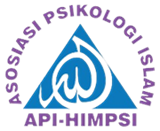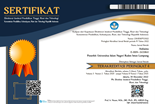Author Guidelines
Manuscript Preparation
Anfusina: Journal of Psychology adopts the American Psychological Association (APA) standards for publications in its guideline for authors policy, both in terms of publication structure (i.e., Introduction, Method, Results, and Discussion or IMRaD) and citation style. Please follow the Publication Manual of the American Psychological Association (7th.ed.) when preparing your manuscript. Manuscripts that do not follow the required APA style will be rejected directly by the Editors.
- The manuscript can be written both in Bahasa Indonesia or English with the standard language.
- The manuscript should consist of six (6) to twenty-five (20) pages including pictures and tables.
- The article is written on B5-sized papers (24 cm x 16 cm), with custom margins as follows: left 2.3 mm, right 2.3 mm, bottom 2.3 mm and top 2.3 mm.
- The text of the articles must be in Times New Roman, 11.5pt font size, 1 line-spacing
General Author Guidelines
Title
The title of the manuscript should be written on the top of the first page with the center text alignment. The title is written in Times New Roman font at the top of the page. Abbreviations should be avoided within the title. Witty or creative titles are welcome, but only if relevant and within the measure. Title should be kept concise, informative, and interesting. Keep the title no more than 14 words.
Affiliation
Provide each author’s affiliation and contact address. Meanwhile, the author’s name (without an academic degree), and the affiliation address of the author should be written with the center text alignment also under the title of the article.
Abstract
Abstract should be written in both English and Bahasa Indonesia languages. The length of abstract should be no more than 250 words and is written in a single paragraph. Briefly describe the background, objective, methodology, findings, and conclusion. Avoid using abbreviations and citations. The keywords or phrases must be written below the overall abstract for all words. Those should be arranged in alphabetical order and be separated by semicolon maximally three to five words.
Introduction
This section should briefly provide information on the background of the research, or the problem being addressed, literature review, state of the originality of the work, hypothesis, and research objective.
Method
Consists of an explanation of the approach and research methods used, describe the instrumentation, describe the procedures, population and samples, data collection techniques, data validation techniques, and data analysis techniques.
Result and Discussion
Provide clear and concise results and compare them with the results of previous studies and adapted theories. The purpose of the Results and Discussion is to state your findings and make interpretations and/or opinions, explain the implications of your findings, and make suggestions for future research. Its main function is to answer the questions posed in the introduction, explain how the results support the answers and, how the answers fit in with existing knowledge on the topic. The Discussion is considered the heart of the paper and usually requires several writing attempts.
Tables and figures may be used when necessary for effective presentation of the findings, but should not be redundantly explained in the paragraphs. When interview is used as data collection method, this section should also contain direct quotations of meaningful participants’ transcripts that support the findings.
Conclusion
The main conclusions of the study should be presented in a short conclusions section, which should not simply repeat earlier sections. Should be consisting of answering research problem, based on the theoretical significance/conceptual construction.
References
All references must be recent publications (up to the last 10 years). All sources that are cited in the text must be included in the Reference list. The journal uses APA citation style. Please check Publication Manual of the American Psychological Association (7th. ed.) Authors are strongly urged to use a reference manager such as Mendeley to build their bibliography.
Datasets that have been deposited to an online repository should be included in the reference list, include the version and unique identifier when available. For accepted but unpublished works use "in press" instead of page numbers. Unpublished data, submitted manuscripts, or personal communications should be cited within the text only, for the article types that allow such inclusions. Personal communications should be documented by a letter of permission.
Examples of references:
Journal article | Gabriel, B., Beach, S. R. H., & Bodenmann, G. (2010). Depression, marital satisfaction and communication in couples: Investigating gender differences. Behavior Therapy, 41, 306-316. https://doi.org/10.1016/j.beth.2009.09.001 |
Journal article (in press) | Baldwin, M., & Keefer, L. A. (in press). Being here and now: The benefits of belonging in space and time. Journal of Happiness Studies. https://doi.org/10.1007/s10902-019-00214-7 |
Journal article (early view/advance online publication) | Allan, H. (2010). The perils facing nurse education: A call for leadership for learning. Nurse Education Today. Advance online publication. https://doi.org/10.1016/j.nedt.2010.01.002 |
Journal article (electronic) | de Boer, M. J., Steinhagen, H. E., Versteegen, G. J., Struys, M. M. R. F., & Sanderman, R. (2014). Mindfulness, acceptance and catastrophizing in chronic pain. PloS One, 9(1), Article e87445. https://doi.org/10.1371/journal.pone.0087445 |
Thesis (from website) | Axford, J.C. (2007). What constitutes success in Pacific Island community conserved areas? [Doctoral Dissertation, University of Queensland]. UQ eSpace. http://espace.library.uq.edu.au/view/UQ:158747 |
Thesis (from database) | Leigh, J. (2010). Self-determined mindfulness and attachment style in college students (Publication No. 305210119) [Doctoral Dissertation, Indiana State University]. ProQuest Dissertations and Theses Global. |
Book | Azwar, S. (2012). Penyusunan Skala Psikologi Edisi 2. Pustaka Pelajar. |
Data from the Internet | Dinas Pendidikan Tinggi Republik Indonesia. (2015, December 10). Grafik jumlah mahasiswa aktif* berdasarkan jenis kelamin. http://forlap.dikti.go.id/mahasiswa/homegraphjk |
Newspaper/magazine | Chamberlin, J., Novotney, A., Packard, E., & Price, M. (2008, May). Enhancing worker well-being: Occupational health psychologists convene to share their research on work, stress, and health. Monitor on Psychology, 39(5), 26-29. |
Newspaper/magazine (online) | Fachrudin, F. (2016, September 8). Ketentuan soal perzinahan dalam KUHP dinilai perlu diperluas. Kompas. http://nasional.kompas.com/read/2016/09/08/18302141/ ketentuan.soal.perzinahan.dalam.kuhp.dinilai.perlu.diperluas |
Newspaper/magazine (no author) | Usaha macet, ditipu paranormal miliaran rupiah. (2008, Oktober 5). Kompas Online. http://www.kompas.com/read/xml/2008/10/08/16213644/usaha.macet. kena.tipu.paranormal.miliaran. |
Book chapter | Diener, E., Lucas, R.E., & Oishi, S. (2002). Subjective well-being: The science of happiness and life satisfaction. Dalam Synder, C.R. & Lopez, S.J. (ed.) Handbook of Positive Psychology (pp. 139-170). Oxford University Press. https://doi.org/10.1016/j.ahgj.123.456.89 |
| |
Manuscript submitted for publication | Himawan, K. K. (2017). I Need Thee Every Hour: Religiosity and Well-Being of Single Adults. Manuscript submitted for publication. |
Figures and Tables
Tables are a concise and effective way to present large amounts of data. All tables and figures should be referenced in the text. Author may use a sentence to indicate the desired location of Table /Figure (i.e., Figure 1 near here). Figure and table are required to have the same font as the main text (10 points normal Times New Roman, single-spaced). Figure and table should be preceded by the appropriate label, for example, "Figure 1" or "Table 4". Author must also explain the relation between the table/figure and the text. The reference table uses the APA 7th Edition











